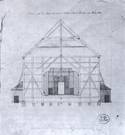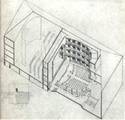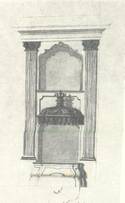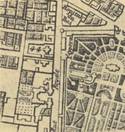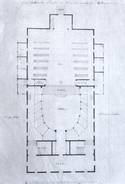Important events
King Stanislaw August Poniatowski moved renovation of the building. He ordered to build a paint shop and installing modern equipment. The king ordered to Szymon Bogumił Zug the renewal of the theater project.
People
One of the most versatile and prolific architects of his epoch. Zug supervised the refurbishment of Warsaw Arsenal and designed the romanticist ruins in the garden of Arkadia near Łowicz. He is buried there in the Evangelical Cemetery of the Augsburg Confession in Warsaw.
He had been in Poland since 1724, where together with his father undertook the erection of many buildings in the high baroque style.
History
The theatre of King Augustus III, first called the Opernhaus and then the Saxon Opera House, was built in the corner of Saxon Garden by Królewska Street in the middle of 1748. The first free-standing theatre building in Warsaw was designed by Carl Friedrich von Pöppelmann. Constructed from timber-framing, it was about 52 metres long and 19 metres wide. The building had three storeys on the entrance side (in the shorter side of the rectangle) and four storeys on the side of the stage. The modest but elegant interior consisted of three parts: the vestibule with staircases, the house, and the stage with dressing rooms. The horseshoe-shaped auditorium had seats for dignitaries and rows of benches in the stalls, as well as four storeys of boxes and two stage boxes; the right one hosted the royal couple. The stage, first equipped with four, then with six pairs of wings was closed by a semicircular back drop. The theatre could house about 540 people. Initially tickets were given to the interested, but by the end of the reign of the Saxon king they were already being sold. The inaugural performance of an Italian comedy took place on 3 August 1748, on the king’s name day. The Saxon Opera hosted Italian, German and French companies. The greatest performances, with décor by Giuseppe Galli-Bibiena, were given by an Italian opera company from Dresden.
After the death of Augustus III (1763) the building quickly went into ruin. In 1765, King Stanisław August, aiming at establishing a permanent public theatre in the capital, rented the Opera House and had it renovated. On 8 May a French comedy troupe performed there, and on 7 August an Italian opera company played. On 19 November the newly established Polish company of “the actors of His Majesty the King” played Józef Bielawski’s comedy Intruders (Natręci). That was how the National Theatre was established, in the first period acting only for a year and a half, until March 1767. Later on, the Opera House was leased by the Russian ambassador, Nicholas Repnin, and was rented to foreign companies. In 1769 Stanisław August removed the décor and equipment, as being his property. The dilapidated building of the Opera House was knocked down in the spring of 1772.[1]
[1] In 1965 a commemoration stone was placed on the side of the building at the corner of Królewska and Marszałkowska Streets. Barbara Król, Budynek Operalni Saskiej w Warszawie, “Pamiętnik Teatralny” 1956 No. 4; Barbara Król-Kaczorowska, Teatry Warszawy. Budynki i sale w latach 1748–1975, Warszawa 1986.
Literature:
-
Król-Kaczorowska B., Budynek Operalni saskiej w Warszawie, „Pamiętnik Teatralny” 1956 No. 4 p. 631–650.
-
Król-Kaczorowska B., Dwie Operalnie, „Pamiętnik Teatralny” 1966 No. 1–4, p. 48–65.
-
Król-Kaczorowska B., Teatr Dawnej Polski. Budynki, dekoracje, kostiumy, Warszawa 1971.
-
Król-Kaczorowska B., Teatry Warszawy, Warszawa 1986.
-
Kwiatkowski M., Przyczynek do dziejów Operalni, „Pamiętnik Teatralny” 1965 No. 1, p. 91–93.
Author: Jarosław Komorowski
Jarosław Komorowski:
Royal Theatre in the Old Orangery, Theatre on Krasiński Square, Theatre in the Castle Museum, Opernhaus, Amphitheatre in Royal Łazienki, Theatre Room in the Castle of Wacław Rzewuski, Theatre of Antoni Sułkowski, Theatr of Sapieha in Różana, Fencing School, Collegium Nobilium Theatre, Theatre building near Hetman Jan Branicki’s palaceAdditional information
No information has yet been entered
Add information




